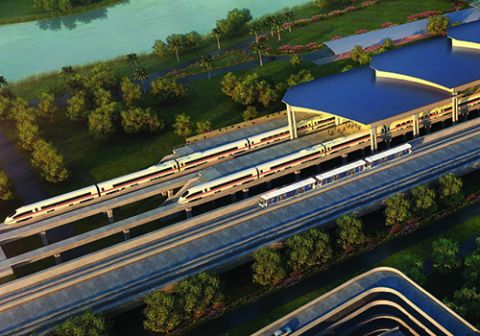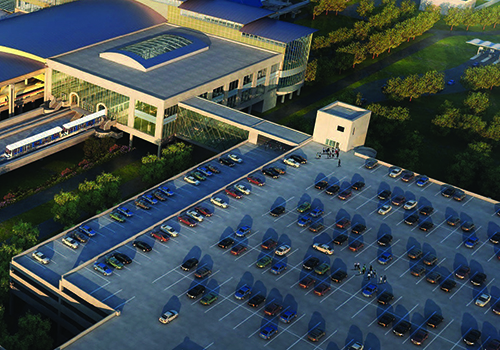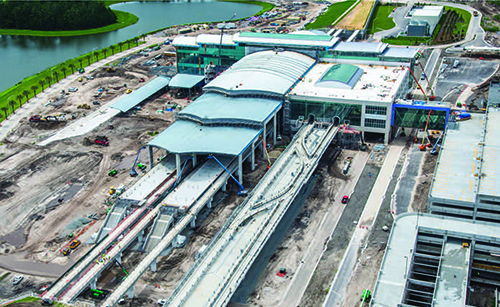Automated People Mover Sets the Stage for Less Curb Congestion, New Intermodal Connections at Orlando Int'l

Orlando International Airport (MCO) is on track for continued growth and increased intermodality with the debut of its South Airport Automated People Mover System early this fall.
"We are excited about the opening of the people mover system because it is not only a new generation of people movers, but it is the beginning of a new era for Orlando International," says Phil Brown, executive director of the Greater Orlando Aviation Authority. "We are at the cusp of really being able to accommodate planes, trains, and automobiles."
The system itself features six state-of-the-art passenger cars from Mitsubishi Heavy Industries America. In July, the cars were being tested on the 1.4-mile dual-lane guideway that connects MCO's current North Terminal Complex to its future South Terminal Complex, which includes a new parking garage and state-funded intermodal center.
 facts&figures Project: Automated People Mover & Associated Station Location: Orlando Int'l Airport Operator: Greater Orlando Aviation Authority Primary Goals: Connect North Terminal to future South Terminal, associated parking garage & regional rail lines; relieve curb congestions at North Terminal by offering new parking & check-in options at South Terminal South Airport Automated People Mover Complex & Intermodal Terminal Facility: $684 million General Complex Funding: Revenue Bonds, Passenger Facility Charges Intermodal Terminal Facility Funding: State of Florida Debut of People Mover Service: August 2017 Projected Debut of South Terminal & Expanded Garage: 2020 Prime Architect: SchenkelShultz Architecture Civil & Transportation Engineer: Atkins Intermodal Terminal Facility Construction Manager at Risk: Turner Kiewit APM Station & Parking Garage Construction Manager at Risk: Hensel Phelps APM Supplier: Mitsubishi Heavy Industries America APM Operations & Maintenance: MHIA; Sumitomo Corp.-Crystal Mover Services Remote Check-In: Bags, Inc. |
Each car is designed to carry up to 44 passengers and travel at speeds of up to 42 miles per hour. The system is scheduled to be operational in fall 2017.
"We started this project off to relieve congestion," Brown explains, noting that the main North Terminal was facing curb crowding on all three levels: commercial, passenger arrivals and passenger departures. "We needed to get a solution where we could move some of the traffic off the roads and into a different location."
Per the airport authority's master plan, MCO is expanding its terminal facilities to the south, with a 16-gate South Terminal that is scheduled to open in 2020. The new automated people mover will not only connect the existing North Terminal with the new facilities, a new $684 million South Airport Automated People Mover Complex will provide travelers using either terminal new parking and check-in options. And if all goes according to plan, it will eventually connect travelers and employees to multiple rail lines.
Automobile Component
The new 2,400-space parking garage at the South Terminal Complex is a welcome addition for passengers and the airport authority alike, because parking facilities at the North Terminal are often full.
"Unfortunately, we are in a situation where the parking garage is closed at the North Terminal Complex three to four days a week," reports Brown. "That is revenue lost for us, but it is also an inconvenience for the passengers, which is what we are most concerned about."
Brown predicts that MCO travelers will be pleased with the new array of options, including remote check-in. "You can check in your bag at the garage, take the people mover up to the North Terminal, and after you disembark, you will walk right out into the main terminal and Hyatt lobby, with convenient access to any one of our four airsides to catch your plane," he explains.
When the South Terminal opens in 2020, the new garage will also allow ready access to it.
"We have $3.5 billion in capital investment underway, and the bulk of that is $2.15 billion related to a South Terminal Complex that we have under design," Brown explains. "We have already started some horizontal site work out there and we will be in construction with other elements including roadway and taxiway access, as well as vertical construction of the landside and airside of the terminal."
In July, the South Terminal design was 60% complete and had received board approval for completion of the full design.
Train Component
In addition to connecting travelers to more gates, the people mover system supports the airport authority's longstanding plans for an intermodal facility with connections to passenger rail systems.
Ultimately, the South Terminal Complex will include a 1.3 million square-foot Intermodal Terminal Facility, which will serve as a hub for an intercity passenger rail line from Miami that is in the works but experiencing delays.
Shortly after the airport authority started planning its people mover project, officials were approached by representatives of All Aboard Florida, a project to establish a passenger rail system from Miami to Orlando-the first privately funded intercity train system in the United States, notes Brown. "We spent several years negotiating agreements, and they are in the process of trying to get permits and get through some litigation to be able to construct a 35-mile spur from Cocoa to Orlando International Airport to allow intercity passenger rail from downtown Miami to Orlando International."
The original timeframe the authority negotiated with All Aboard called for rail operations to begin servicing MCO at the same time the airport unveiled its new people mover system and intermodal facility. While that will not happen due to railway-related factors, Brown reports that All Aboard-recently rebranded as Brightline-is still committed to the project. Based on current information, he anticipates Brightline rail service to debut at MCO in 2020.

In addition to Brightline's projected regional service, SunRail plans to provide commuter rail services into MCO's Intermodal Terminal Facility. Plans call for SunRail passengers to arrive at the airport's intermodal facility from the south, and then take a three-minute ride to the North Terminal complex on the new automated people mover or simply walk to the new South Terminal (after it opens in 2020).
Eventually, authority officials hope that the airport will also be served by a light rail system running to and from the Orange County Convention Center in Orlando. "The challenge there is that the Florida Department of Transportation, which operates SunRail right now, has re-estimated the cost of the connection to the airport. It has gone from $100 million to $250 million, and there is no funding in place for that."
Federal funding is being pursued to overcome this major impediment, he adds.
"We are working as closely as we can with SunRail," Brown relates, noting that commuter service would benefit airport workers as well as passengers.

Plans dating back to the 1980s included four modes of rail at MCO: regional, intercity commuter, light rail to the convention center and intra-airport.
"I think we have been pretty fortunate in that we have been able to execute along our original timeframe," reflects Brown. "When we started the project, we said that we would be operational in 2017; and we will be."
The entire project, however, has underscored the importance of contingency planning. "We have learned that when it comes to rail projects, funding and timing is critical-and if you have an aggressive schedule, you better have a backup plan in case it doesn't come to fruition, which is what we're seeing now with both SunRail and Brightline."
Despite delays from outside entities, Brown reports that the airport authority is cautiously optimistic about the addition of external rail service.
"We will have the airport people mover system, the parking garage and the people mover station, which is what we originally anticipated would relieve congestion," Brown explains. "The others are sort of icing if we can get them."

2022 Charlotte Douglas International Airport Report of Achievement
 Giving back to the community is central to what Charlotte Douglas International Airport and its operator, the City of Charlotte Aviation Department, is about, and last year was no different.
Giving back to the community is central to what Charlotte Douglas International Airport and its operator, the City of Charlotte Aviation Department, is about, and last year was no different.
Throughout 2022, while recovering from the COVID-19 pandemic, we continued our efforts to have a positive impact on the Charlotte community. Of particular note, we spent the year sharing stories of how Connections Don't Just Happen at the Terminal - from creating homeownership and employment opportunities to supporting economic growth through small-business development and offering outreach programs to help residents understand the Airport better.
This whitepaper highlights the construction projects, initiatives, programs and events that validate Charlotte Douglas as a premier airport.
Download the whitepaper: 2022 Charlotte Douglas International Airport Report of Achievement.








